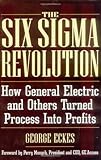General Electric’s Six Sigma Revolution: How General Electric and Others Turned Process Into Profits
General Electric’s Six Sigma Revolution: How General Electric and Others Turned Process Into Profits
- ISBN13: 9780471388227
- Condition: New
- Notes: BRAND NEW FROM PUBLISHER! 100% Satisfaction Guarantee. Tracking provided on most orders. Buy with Confidence! Millions of books sold!
Applying this revolutionary management strategy to drive positive change in an organization
Currently exploding onto the American business scene, the Six Sigma methodology fuels improved effectiveness and efficiency in an organization; according to General Electric’s Jack Welch, it’s the “most important initiative [they] have ever undertaken.” Written by the consultant to GE Capital who helped implement Six Sigma at GE and GE’s General Manager of e-Commerce, Making Six Sigma Last offers businesses the tools they need to make Six Sigma work for them–and cultivate long-lasting, positive results. Successful Six Sigma occurs when the technical and cultural components of change balance in an organization; this timely, comprehensive book is devoted to the cultural component of implementing Six Sigma, explaining how to manage it to maintain that balance. The authors address how to create the need for Six Sigma; diagnose the four types of resistance to Six Sigma and how to overcome them; m
List Price: $ 50.00
Price: $ 4.80
Check This:
 Certified Six Sigma Green Belt Exam Flashcard Study System: CSSGB Test Practice Questions & Review for the Six Sigma Green Belt Certification Exam
Certified Six Sigma Green Belt Exam Flashcard Study System: CSSGB Test Practice Questions & Review for the Six Sigma Green Belt Certification ExamCertified Six Sigma Green Belt Exam Flashcard Study System uses repetitive methods of study to teach you how to break apart and qu…
 Statistics for Six Sigma Green Belts with Minitab and JMP (paperback)
Statistics for Six Sigma Green Belts with Minitab and JMP (paperback)The only book on the market that provides a simple nonmathematical presentation of the statistics needed by Six Sigma Green Belts….
 Design for Six Sigma for Green Belts and Champions: Applications for Service Operations–Foundations, Tools, DMADV, Cases, and Certification
Design for Six Sigma for Green Belts and Champions: Applications for Service Operations–Foundations, Tools, DMADV, Cases, and CertificationThis is the eBook version of the printed book.Most Six Sigma books are targeted at manufacturers, and don’t reflect the unique imp…
 Six Sigma Workbook For Dummies
Six Sigma Workbook For DummiesImprove your efficiency — and bring in big profits!Need help implementing or understanding Six Sigma? Want to take this powerful …



Intriquing Application for Business & Beyond!,
I read the Six Sigma Revolution because of my facination with exploring ways to improve the quality of life, both as it relates to business as well as to relationships and life generally. Every now and then an author comes along who not only has technical expertise but also has both feet on the ground. George Eckes has painted a picture that illustrates not only mastery of Six Sigma content, he also exemplifies giftedness by communicating profoundly detailed concepts and principles with clarity and simplicity. And he paints his picture with splashes of fun and humor.
I believe that anyone who is committed to improving effectiveness and efficiency in their world, whether in their business or in their personal lives, can benefit significantly by reading the Six Sigma Revolution. I’m looking forward to getting a copy of his next book, Making Six Sigma Last.
Was this review helpful to you?

|An Insider’s Look at the Six Sigma Revolution,
Having graduated from Jack Welch’s School for Wayward Boys, I found George Eckes’ “The Six Sigma Revolution” to be a revelation.
I left GE some months ago quite frustrated with the company’s application of Six Sigma. Even though all salaried employees were trained as Green Belts, even though all managers took great care to spout the proper nostrums at the proper times, nothing really changed much in how we operated.
I worked on a new product program which served more as salve to the egos of engineers than to improve our product for our customer. I and a few others fought valiantly to ensure that the voice of the customer was injected into the process, and that the design capability was measured and reported through Six Sigma scorecards. This was all deemed to be unimportant in the rush to get the product to market.
Eckes’ book reveals why this was so.
Early on, he had counseled Jack Welch that Six Sigma rests on two pillars: customer satisfaction and process capability. It’s quite simple: ask the customer what he wants and fine tune your process to efficiently deliver it. Thus you both increase revenue (through customer loyalty and product quality) and decrease costs (by eliminating the hidden factory and focusing only on customer CTQs). Welch being Welch, he completely ignored the former and focused on the latter, to great effect.
In 1999, Welch realized that this was a mistake, as customer after customer inquired why they didn’t notice a change in GE’s products and services after the Six Sigma introduction. While shareholders realized double-digit growth year after year, customers saw the same old mixed bag of products and services. Welch immediately launched a major initiative to reduce customer span and inject the voice of the customer into GE processes.
Eckes, to his credit, indulges in a bit of well-deserved “I told you so.” After all, it’s not often one proves the most admired CEO in the world to be wrong.
This is an excellent book covering the whys and wherefores of a Six Sigma introduction. For those of us in the trenches trying to effect lasting change in our companies, this is an indispensable resource. If you’re looking for an in-depth guide to the tools employed in Six Sigma project execution, grab “Implementing Six Sigma” by Forrest Breyfogle instead.
Was this review helpful to you?

|